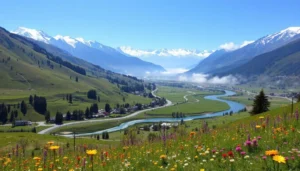Thinking about exploring the world’s most stunning travel forest destinations? You might wonder what makes these places so special. What draws people to the best forest hikes for beginners, and how can you find the magic of underrated forest trails around the world?
Imagine being surrounded by tall trees, diverse wildlife, and stunning landscapes. This is what makes these travel forest destinations so captivating. With the right gear and knowledge, you can explore the best forest hikes for beginners. You’ll discover the hidden gems of underrated forest trails around the world.
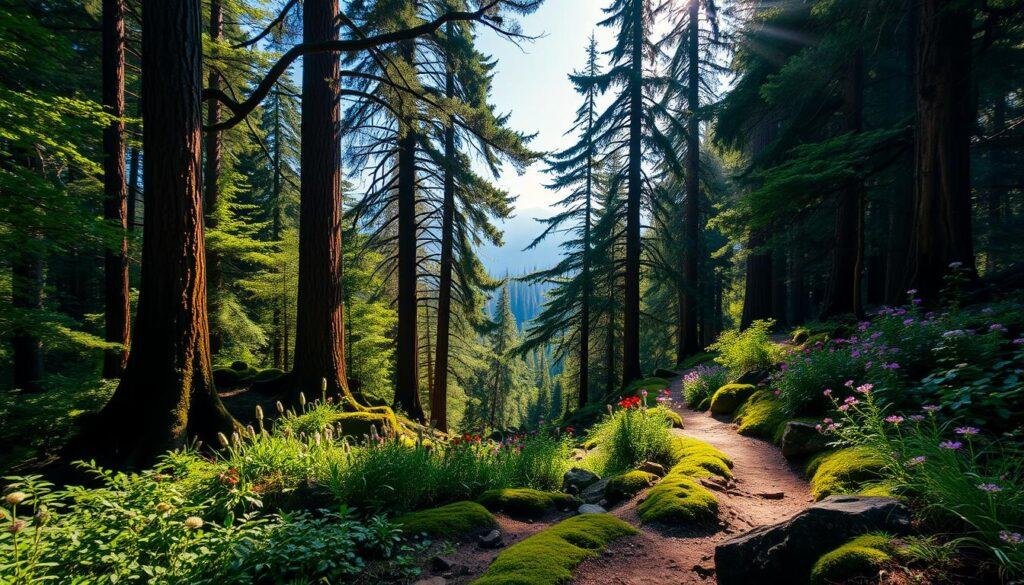
Key Takeaways
- Exploring the world’s most beautiful travel forests can be a life-changing experience
- Best forest hikes for beginners offer a unique and captivating experience
- Underrated forest trails around the world are waiting to be discovered
- Having the right gear and knowledge is essential for a successful forest hike
- Travel forest destinations offer a chance to connect with nature and oneself
- Forest hiking can be a great way to improve physical and mental health
Discovering the Magic of Forest Hiking
Starting your journey to explore the world’s most beautiful forests is exciting. You’ll find out what makes forest hiking special. With the right essential gear for forest hiking adventures, you can dive into the forest’s natural beauty. This way, you’ll experience the magic of forest hiking.
Forest hiking has many benefits. It’s great for your body, thanks to exercise and fresh air. It also helps your mind, with forest bathing and being in nature. Knowing about forest ecosystems helps you see their complexity and beauty. Some key benefits include:
- Improved physical health
- Reduced stress and anxiety
- Increased sense of connection to nature
When planning your forest hike, think about visiting top rainforest hiking destinations worldwide. With the right gear and knowledge, you can confidently explore these unique ecosystems.
Exploring forest hiking means respecting nature and practicing responsible travel forest tourism. This way, you help keep these incredible ecosystems beautiful for others to enjoy in the future.
Essential Gear for Your Forest Adventure
Getting ready for your forest trip means having the right gear. This ensures a safe and fun journey. For seasonal forest hikes, know the best times to go and follow safety tips. You’ll need sturdy boots, comfy clothes, and a first-aid kit.
It’s key to know how to navigate with a map and compass. Always check the weather forecast and pack for it. A well-stocked backpack with food, water, and shelter is vital for your adventure.
Here are some must-haves for your backpack:
- Navigation tools: map, compass, and GPS device
- First-aid kit: bandages, antiseptic wipes, and pain relievers
- Shelter and warmth: tent, sleeping bag, and extra clothing
- Hydration and nutrition: water bottle, water purification tablets, and energy-rich snacks
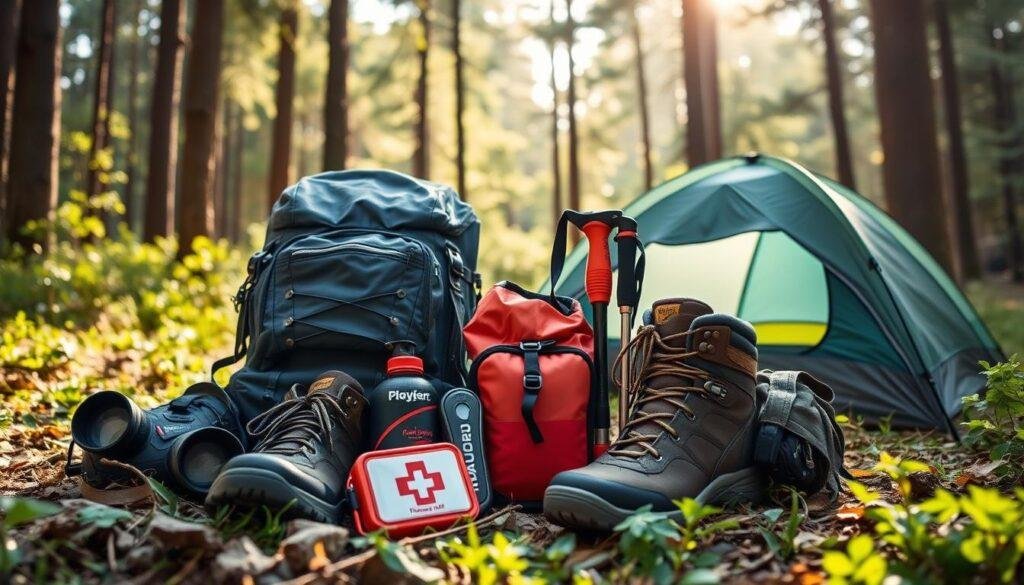
By following these safety tips and being prepared, you’ll have a great time in the forest. Always put safety first and respect nature. You’ll be set for an amazing adventure.
The World’s Most Stunning Travel Forest Destinations
Planning your next forest adventure? You’ll find amazing landscapes and experiences. From tall trees to lively wildlife, each place offers a mix of nature and culture.
While exploring, look out for the wildlife to watch for on forest trails. You’ll see birds, mammals, and insects. Also, learn about the cultural insights on famous forest trails that make these places special.
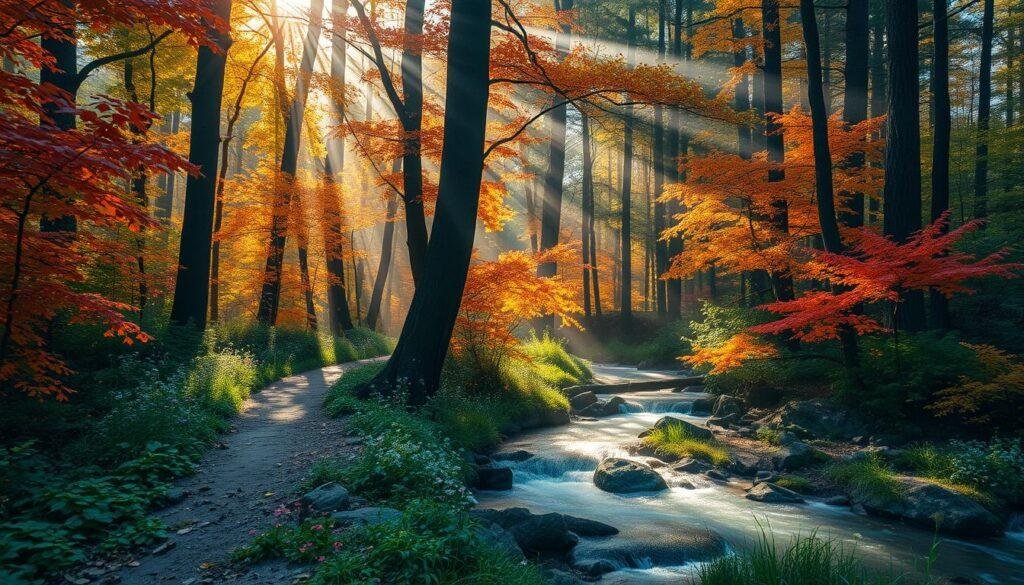
Ancient Redwood Forests of California
The ancient redwood forests in California are a must-see for nature fans. These forests show us what the past looked like with their huge trees and green canopies.
Amazon Rainforest Trails
The Amazon rainforest trails are perfect for wildlife lovers. You’ll find many species here. As you walk, think about the cultural insights on famous forest trails that have shaped this area’s history and identity.
Black Forest Hiking Routes in Germany
The Black Forest hiking routes in Germany are a mix of beauty and culture. With its hills and villages, it’s a top spot for travel forest fans.
Japanese Cedar Forests of Yakushima
The Japanese cedar forests of Yakushima are peaceful. Their tall trees and calm landscapes are perfect for exploring. Keep an eye out for the amazing wildlife to watch for on forest trails that live here.
Preparing for Your First Forest Hike
Starting your first forest hike? It’s key to know the physical demands. Make sure you’re in shape to handle the trails. Regular exercise and cardio will prepare you for uneven terrain and weather changes.
Understanding maps and compasses is vital. A GPS or smartphone app can also guide you. Plus, eco-friendly hiking practices like using reusable water bottles are important. They help protect the environment.
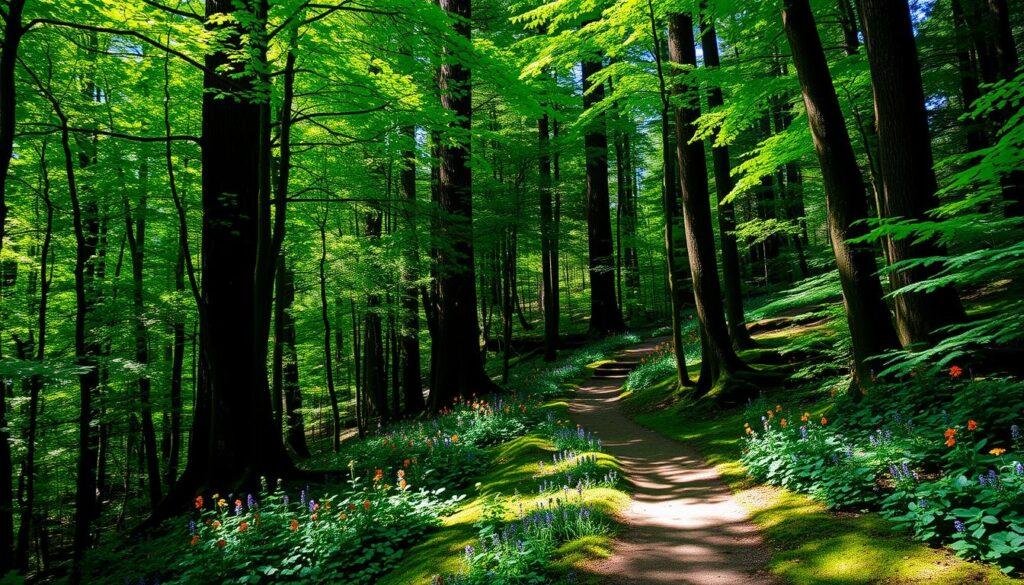
Want to capture the forest’s beauty? Learn about photography for landscapes. This includes lighting, composition, and the best photo times. Your photos will show the forest’s stunning views. Always respect the environment and follow eco-friendly practices.
For your first forest hike, remember:
- Physical conditioning: build up your endurance through regular exercise
- Navigation skills: learn how to read maps and use a compass
- Weather considerations: check the forecast and be prepared for changing conditions
- Eco-friendly practices: minimize waste, respect wildlife habitats, and follow leave-no-trace principles
Safety Measures in Dense Forest Environments
When you go on beautiful forest hikes, safety is key. The dense forests of top hiking spots can be risky if you’re not careful. To have a great time, be aware of your surroundings and watch out for dangers like steep slopes and wildlife.
Some of the best trails offer amazing views, but being ready for emergencies is important. Always carry a first aid kit and know how to use it. It’s also smart to tell someone where you’re going and when you’ll be back. In an emergency, having a way to call for help, like a cell phone, can save your life.
Here are some safety tips for dense forests:
- Stay on marked trails to avoid getting lost
- Be mindful of changing weather conditions
- Keep a safe distance from wildlife
- Bring plenty of water and snacks

By following these safety tips, you can enjoy the beauty of forest hikes without worry. Always put your safety and the safety of others first. This way, you can fully enjoy the best trails and travel forest adventures.
| Safety Tip | Importance |
|---|---|
| Carry a first aid kit | High |
| Let someone know your itinerary | High |
| Stay on marked trails | Medium |
Wildlife Encounters and Natural Photography
When you explore scenic forest hiking routes, you might see many animals. This includes birds, squirrels, deer, and even bigger animals. Famous hikes, like those in the Amazon Rainforest or Japan’s Yakushima, let you see rare species in their homes.
Knowing how animals act and when to see them is key. Early morning and late evening are best for spotting deer and other big animals. Try hiking during these times to see more wildlife.
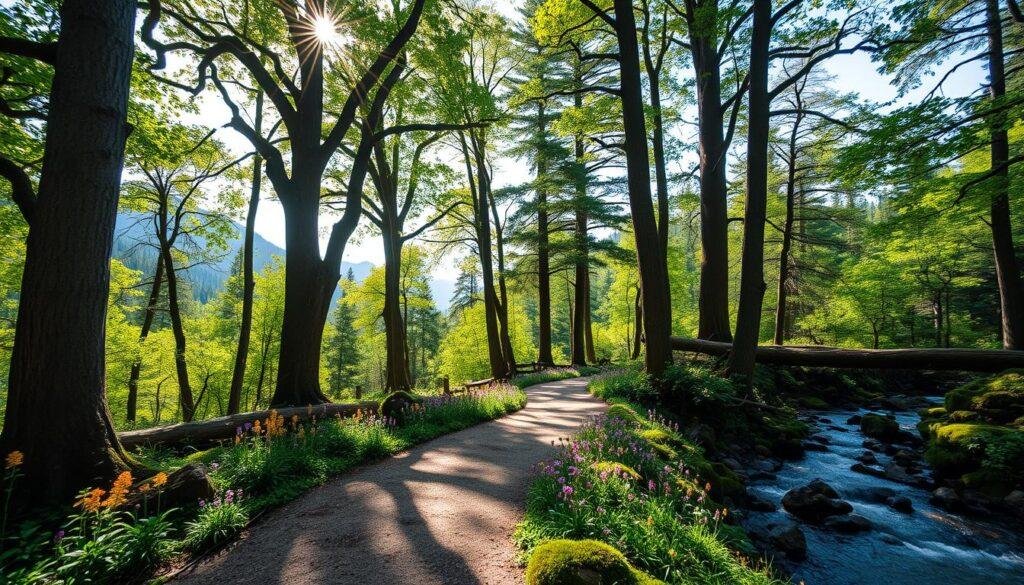
For capturing these moments, you need the right camera tips and gear. Here are some tips:
- Use a telephoto lens to get close to animals without scaring them
- Take photos during the golden hour for beautiful light
- Be patient and wait for the perfect shot, as wildlife photography takes time
From the most beautiful forest hikes to travel forest spots, there’s much to see. By combining your love of nature with photography, you can make lasting memories. You’ll also inspire others to love the natural world.
Seasonal Considerations for Forest Hiking
When planning your forest hike, think about the seasons. Each season brings its own charm to forest trails worldwide. Spring and autumn offer special views of the forest.
Knowing the best times to visit certain trails is key. This way, you can safely enjoy the forest’s beauty. Famous spots include the Amazon Rainforest, Germany’s Black Forest, and Japan’s Yakushima Cedar Forests. These places offer everything from short walks to long treks.
Here are some tips for a great forest hike:
- Check the weather forecast before heading out on a hike
- Bring appropriate gear, including clothing, footwear, and navigation tools
- Respect the forest environment and wildlife, and follow any local regulations or guidelines
With careful planning, your forest hike can be both safe and fun. Whether you’re an experienced hiker or new to it, there’s a trail waiting for you.
Cultural Significance of Famous Forest Trails
As you explore the world’s most famous forest trails, you’ll learn about their rich cultural heritage. These trails offer a chance to see the history and traditions of the places you visit. From the first inhabitants to today’s hikers, the stories of these trails are truly fascinating.
Traveling these trails is more than seeing nature’s beauty. It’s also about the history and culture that have shaped these paths. Understanding this cultural impact helps you appreciate these trails even more.
Indigenous Perspectives
Indigenous communities have lived with the forest for centuries. They have a deep connection to the land and its ways. Their views on the forest are invaluable, showing us the history and traditions of the area.
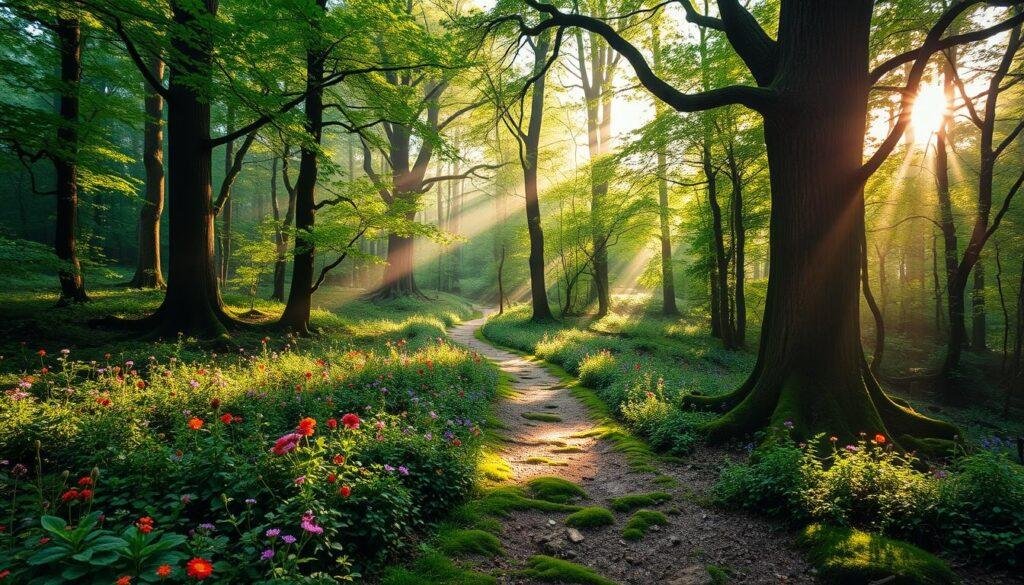
Historical Forest Routes
Many trails have been used for centuries, some for thousands of years. These routes give us a peek into the past, showing how humans have interacted with the forest. By walking these paths, you can learn about the forest’s cultural and historical importance.
Modern Cultural Impact
Today, forest trails are important in modern culture. People visit them for fun, relaxation, and inspiration. The trails’ cultural impact is seen in their role in our society, with efforts to protect them for the future.
Advanced Forest Hiking Techniques
As you get better and more confident in hiking, you might want to try new things. You could find hidden gem forest hikes to explore, enjoy family-friendly forest hiking destinations, or tackle challenging forest trails for adventure seekers. With the right skills and prep, you can conquer tough trails and enjoy your travel forest trips more.
Here are some advanced techniques to start with:
- Navigation in dense coverage: This means using a map, compass, and tools to navigate through thick forests.
- River and stream crossings: You’ll learn how to safely cross over rivers and streams, including using ropes and other gear.
- Emergency shelter building: This skill teaches you how to build a shelter using natural materials like leaves and branches.
Learning these techniques can take your hiking to the next level. Whether you’re searching for hidden gem forest hikes to explore or looking for a challenge on challenging forest trails for adventure seekers, knowing these skills is key. So, start planning your next travel forest adventure today and explore the beauty of family-friendly forest hiking destinations!

Always put safety first, both for yourself and others, when trying advanced hiking techniques. With the right prep and knowledge, you can have a fun and rewarding time exploring the world’s most stunning forests.
| Technique | Description |
|---|---|
| Navigation in dense coverage | Using a map, compass, and other tools to find your way through dense forests. |
| River and stream crossings | Knowing how to safely cross rivers and streams, including how to use ropes and other equipment. |
| Emergency shelter building | Building a shelter using natural materials, such as leaves and branches. |
Responsible Forest Tourism Practices
When you go on nature walks in forests, it’s key to be responsible. This means following local rules, protecting wildlife, and reducing waste. These actions help keep forests beautiful for others to enjoy in the future.
Your adventures in the forest can affect the environment. To lessen this, follow these tips:
- Stay on designated trails to avoid damaging vegetation and wildlife habitats
- Bring all trash and disposable items back with you, and dispose of them properly
- Respect local wildlife and keep a safe distance to avoid disturbing them
When planning your rainforest hikes or forest trips, choose tour operators that care about the environment. This supports local communities and helps protect nature.
Being a responsible tourist helps protect these amazing places. So, when you’re on a forest walk or trek, remember to act responsibly. This way, you help keep these incredible environments safe for the future.
| Responsible Forest Tourism Practices | Benefits |
|---|---|
| Stay on designated trails | Reduce damage to vegetation and wildlife habitats |
| Bring all trash and disposable items back | Reduce waste and minimize environmental impact |
| Respect local wildlife | Help conserve and protect wildlife populations |
Conclusion: Embracing the Forest Journey
As you finish your temperate forest trails journey, think about all you’ve seen and done. You’ve walked through beautiful landscapes and seen many animals. Each step has made you appreciate the world’s most stunning forests more.
Looking ahead, there are endless trails to explore and forests to discover. With the right attitude and planning, you can have a lifetime of forest adventures. You’ll keep exploring the beauty and magic of nature.
Your journey through the forest has changed you. It has made you see the world in a new light and sparked a love for nature. Let this love guide you on your future travels.
Whether you’re hiking in California’s redwoods, the Amazon, or Germany’s Black Forest, each step is special. Remember the lessons you’ve learned and the amazing sights you’ve seen. They will stay with you forever.
FAQ
What are some of the best forest hikes for beginners?
Beginners should check out Muir Woods National Monument in California. The Appalachian Trail in the eastern United States is also great. And the Hoh Rainforest in Washington state is perfect for a gentle start.
Where can I find some of the most underrated forest trails around the world?
For hidden gems, try the Kumano Kodo in Japan. Ontario’s Killarney Provincial Park and Bulgaria’s Rila Mountains are also worth exploring. They offer unique views and cultural experiences without the crowds.
What are some top rainforest hiking destinations?
Top spots include the Amazon Rainforest in South America. The Daintree Rainforest in Australia and Costa Rica’s Monteverde Cloud Forest are also must-sees. They’re home to diverse wildlife and lush vegetation.
What essential gear should I have for forest hiking adventures?
You’ll need sturdy hiking boots and moisture-wicking clothes. A backpack, first-aid kit, and water filter are also key. Don’t forget a compass or GPS, snacks, sun protection, and any needed meds.
What safety tips should I keep in mind when hiking in dense forests?
Always stay on marked trails and bring a map and compass. Let someone know where you’re going and be aware of your surroundings. Carry a whistle and know how to avoid hazards like wildlife and uneven terrain.
What are the best times of year to explore forest trails?
Spring and fall are best for mild weather and beautiful foliage. Summer is great for cooler forests, while winter offers a chance to see wildlife and enjoy snowy landscapes.
What kind of wildlife might I encounter on forest trails?
You might see deer, elk, bears, birds, and small mammals. Even cougars or wolves could be present. Always keep a safe distance and follow local guidelines for wildlife encounters.
What cultural insights can I gain from hiking famous forest trails?
Famous trails often have deep cultural significance. They offer a chance to learn about indigenous traditions and the land’s history. You’ll also see how these spaces impact modern culture.
What are some tips for capturing great forest landscape photos?
Use a wide-angle lens to show the forest’s scale. Pay attention to lighting and try different angles for unique shots. Remember to practice eco-friendly photography to protect the environment.
How can I be an eco-friendly forest hiker?
Follow the “Leave No Trace” principles. Stay on trails, pack out trash, and respect wildlife. Educate yourself on local regulations and best practices for responsible forest tourism.


